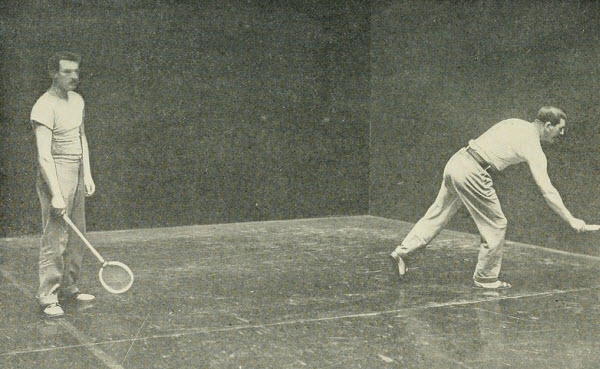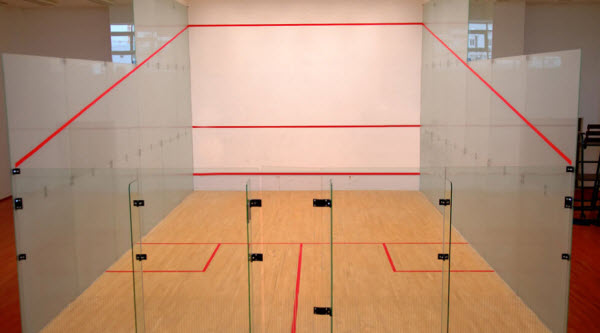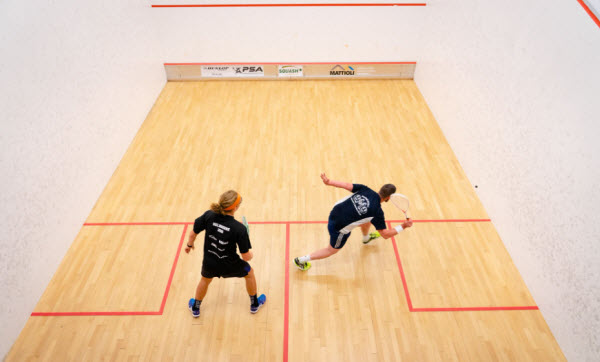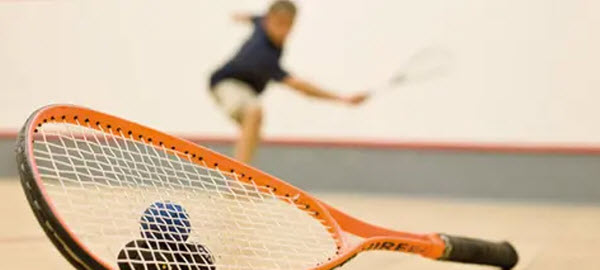Squash is a racquet sport played within a four-walled court. Players use long-handled racquets to hit a small rubber ball against the walls with the aim of making it difficult for their opponent to return the ball effectively. Typically played by two individuals, squash can also be played by four players. This sport demands physical effort, fitness, and patience. There are two main variations of squash: the “soft ball” or British/international version, which features a softer, slower ball and is played in a larger court, and the “hard ball” or American version, popular in the United States, where the ball is stronger and faster, and the game is played in a smaller court. Currently, approximately 20 million people practice squash in 185 countries worldwide, governed by the World Squash Federation (WSF), which is recognized by the International Olympic Committee, despite squash not being included in the Olympic Games.

History of Squash
Squash is a racquet sport that likely originated in the mid-19th century at Harrow School in England. Students who could not access a tennis court began practicing by hitting a rubber ball against a wall. The game quickly gained popularity in other English boarding schools. By the 1890s, dedicated squash courts were being built, and by the end of the century, courts appeared in clubs such as Bath, Queens, and Marylebone Cricket Club. However, squash did not gain widespread popularity until after World War I. In the 1920s, the sport surged in popularity, surpassing even tennis, with the establishment of many courts in clubs, schools, and colleges. The formation of the English National Squash Association and the establishment of game rules, including court dimensions and regulations for the ball and racquet, marked this period. Competitions such as the Professional Championship (1920), the Men’s and Women’s Amateur Championships (1922), and the Open Championship (1930) began to shape the competitive landscape. The game reached international competitions with a British team visiting the United States in 1924, although such contests were later hindered by differences in court types, balls, and scoring methods.

In the United States, early squash was similar to tennis, using a tennis ball and racquet before switching to squash racquets. The game spread from England to the British Empire’s countries, including Canada, India, Australia, and South Africa. Today, squash is played globally, with the World Squash Federation (WSF) promoting the sport and coordinating tours and tournaments among countries. The WSF membership has grown to over 115 countries, each belonging to one of five regional squash federations.
Notable players in squash history include Amr Shabana, an Egyptian amateur who won several British Open titles in the 1930s; the Khan family from Pakistan, who dominated the sport from the 1950s to the 1990s; and Janet Morgan, a British women’s champion from the late 1940s to late 1950s, also winning several American and Australian titles.
How to Play
The international version of squash is played on a rectangular, enclosed court measuring 9.75 meters in length and approximately 6.4 meters in width. The court features several key markings: the service line on the front wall, which the ball must pass over during the serve, and a metal board or padding extending 48 cm from the ground. Hitting this board results in losing the point. There are also lines marking the playable height on the front and side walls, and a short line on the floor indicating where the ball must bounce after being served. The back area, bordered by this line, is divided into two small rectangles where the server stands in one, and the receiver stands in the other, aiming to return the ball.

The objective in squash is to hit the ball against the front wall in a way that prevents the opponent from reaching it. The ball can bounce off the front wall, side walls, or back wall, and can be hit before or after it touches the floor, provided it has bounced off the front wall first. A ball that bounces more than once on the floor is considered dead. Players must give their opponents a fair chance to reach the ball, often meaning moving out of their way after a shot. According to British rules, points are scored only by the player who served first if they win the rally. In American rules, the winner of the rally scores a point regardless of who served. Games can be played to 9 or 15 points, with ties at 8, 13, or 14 points determined by the playing system. Squash involves fast-paced play, requiring excellent hand-eye coordination and quick reflexes. Typically, three referees are used in professional tournaments, with the central referee announcing scores and making decisions along with two side referees.

British squash racquets are similar to tennis racquets but with slightly shorter handles, a maximum length of 68.6 cm, and a maximum width of 21.5 cm, weighing 255 grams. American racquets are heavier. Squash balls are made of rubber or a rubber-butyl composite, measuring 39.5 to 40.5 mm in diameter and weighing between 23 to 25 grams. They are constructed from two pieces glued together to form a smooth, hollow sphere.

Today, there are around 50,000 squash courts worldwide, with 188 countries and regions having at least one court. England has the highest number, approximately 8,500 courts. Other countries with over 1,000 courts include Germany, Egypt, the United States, Australia, South Africa, Canada, Malaysia, France, the Netherlands, and Spain.
